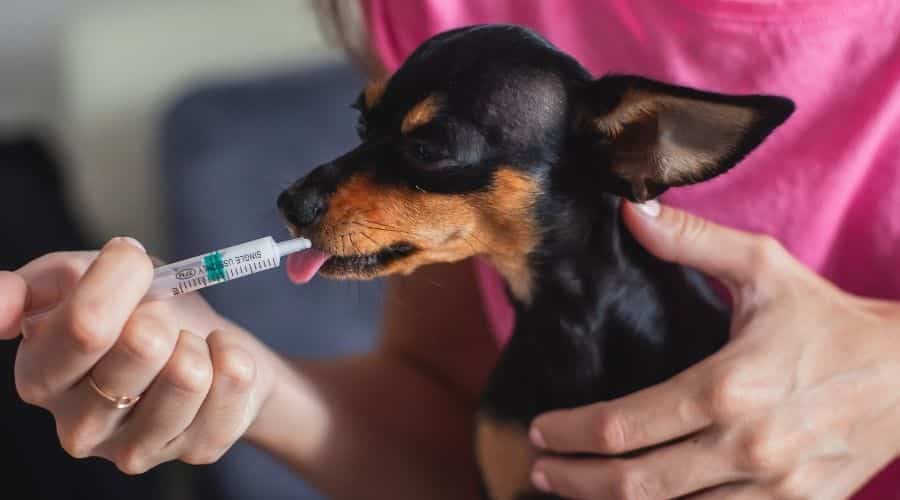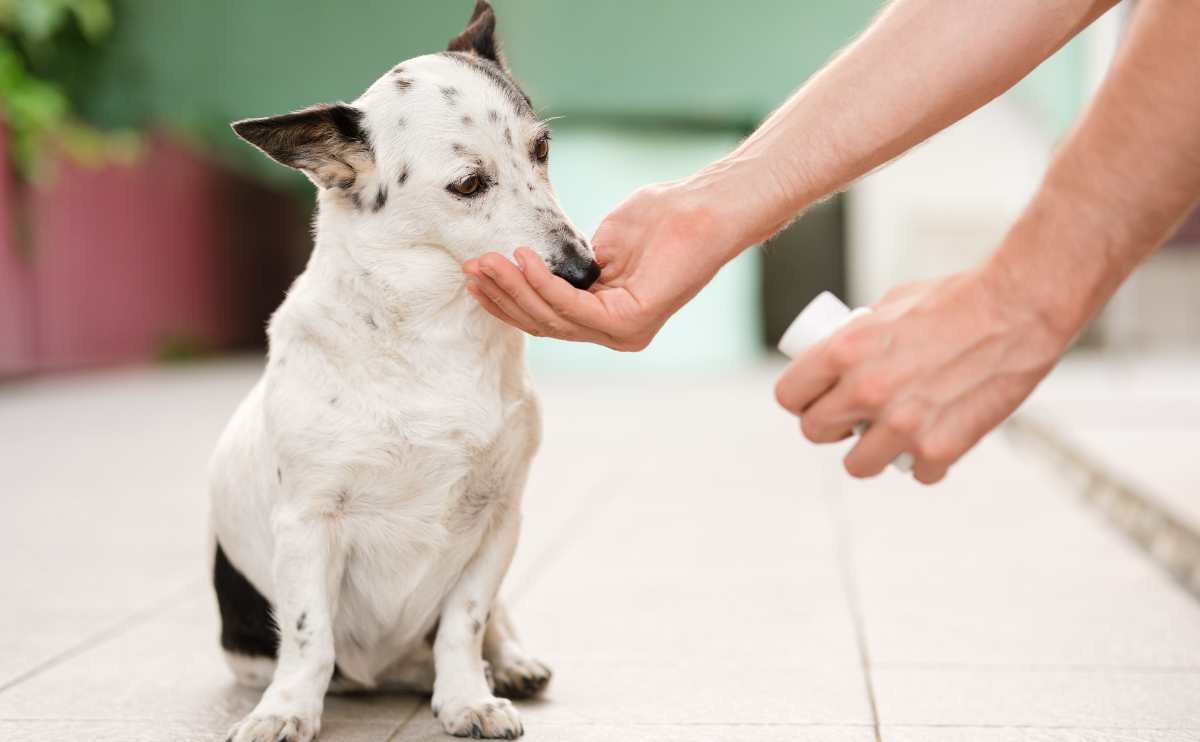Dog Won’t Take Liquid Medicine? Find Out What Really Works
When you purchase through links on our site, we may earn a commission. Here’s how it works.
Your dog won’t take their liquid medicine? You’re not alone. Trying to give a dog a dose of liquid meds can feel like chasing a squirrel on espresso. Messy, frustrating, and downright exhausting. But here’s the good news: it doesn’t have to be that way.
Table of Contents

Whether your pup clamped their jaws shut, spat the medicine across the room, or gave you that look of betrayal, we’ve all been there. And I promise, there are techniques that work (yes, even for the most dramatic dogs).
This guide is packed with vet-approved, real-world strategies to help you give your dog liquid medication without stress, for either of you. I’ll cover step-by-step methods, common mistakes to avoid, and clever tricks that make medicine time a whole lot easier. Because when it comes to your dog’s health, consistency matters, and with the right tools, you can both master how to get a dog to take liquid medicine. So, let’s dive in.
Dog Won’t Take Pills?
This guide focuses on how to get your dog to take liquid medicine. If you’re looking for tips on giving your dog pills instead, check out our step-by-step article on how to give your dog pills.
Why Vets Prescribe Liquid Medicine For Dogs
Giving medicine to dogs can be challenging, especially when pills are involved. Some dogs eat around a pill hidden in food, spit it out, or simply refuse to cooperate. That’s why, as veterinarians, we often turn to liquid medications. Liquid forms can make dosing easier, more precise, and far less stressful for both pets and their owners. Whether you’re dealing with a picky eater, a small breed with dosing needs, or a dog recovering from surgery or illness, liquid medicine offers flexibility and a gentler approach.
When Liquid Makes More Sense
- Smaller or Toy Breeds. For very small dogs, pills can be difficult or even dangerous to administer. Liquid medicine allows for exact dosing based on weight, which is critical in these cases.
- Picky Eaters. Some dogs have a remarkable ability to detect and reject pills, even when they’re hidden in strong-smelling foods. Liquid meds can be more easily disguised or given directly via syringe.
- Chronic Conditions. When a dog requires ongoing medication, such as for heart disease, arthritis, or thyroid issues, liquid forms often simplify the daily routine. They can also be flavored to improve compliance.
- Medical Limitations. Dogs with oral pain, throat conditions, or neurological issues may struggle with swallowing. In these situations, a liquid formulation can reduce discomfort and help ensure proper delivery of the medication.
Liquid Medicine vs. Pills: Pros & Cons For Dogs
Still wondering why your vet chose a liquid medication over a pill, or vice versa? You’re not alone. Both forms of medication can be effective, but they serve different needs. Understanding the pros and cons of each can help you feel more confident and involved in your dog’s care. Here’s what vets consider when deciding between pills and liquid medicine for dogs:
When Pills Make Sense
| Pros | Cons |
|---|---|
| Convenient for travel, as no refrigeration is needed | It can be hard to dose accurately for small or tiny dogs |
| Longer shelf life, which is great for long-term storage | Some dogs detect and spit out pills, even in treats |
| Often more affordable than liquid formulations | Not ideal for dogs with dental issues or trouble swallowing |
| Easy to give if your dog accepts pills willingly | Limited flavor options unless it’s a chewable form |
When Liquid Medicine Is The Better Choice
| Pros | Cons |
|---|---|
| Allows for precise dosing, which is ideal for small dogs or custom regimens | Some dogs dislike the taste, even with flavoring |
| Easier to adjust dose over time based on weight or condition | Can require refrigeration and has a shorter shelf life |
| Can be flavored to improve taste | Can be messy or stressful without proper technique |
| Better for dogs who won’t swallow pills or have medical issues | Sometimes more expensive |
Talk To Your Vet About What’s Best
Your dog’s size, medical condition, behavior, and even your comfort level as a pet parent all factor into the decision. If you’re struggling with one form of medication, don’t hesitate to ask about alternatives. There are often different formulations available.
Ready to turn knowledge into action? Let’s dive into the step-by-step method that makes giving your dog liquid medicine simpler, safer, and way less stressful.
How To Give A Dog Liquid Medicine: A Step-by-Step Guide
Let’s be honest, giving a dog liquid medicine isn’t exactly a walk in the park. Some dogs make it look easy, but for others, it’s like trying to bathe a cat. If your dog clamps their mouth shut or squirms like they’re auditioning for a stunt show, you’re not alone.

The good news? With a bit of prep and a few vet-tested tricks, you can give liquid medication safely, quickly, and without turning it into a full-blown wrestling match. If you have any questions about how a medication should be given, check with your vet first. Here’s the method veterinarians walk pet owners through every day, and it really works.
1. Have Everything Ready
Preparation is key. It goes without saying that you need to be sure of how your dog’s medication should be given before you give it. Your veterinarian should have printed the instructions on the label, so make sure you check. You don’t want to be applying eye drops into their ear or putting a chemical meant as a spot-on into their mouth.
After all, there’s no point in approaching your dog and letting them know something’s up if you then have to pop out to check the label because you can’t remember how many tablets to give. If you think you might need a syringe of water, a tasty treat, or a towel to clean up any mess, get them all ready before you start.
2. Read The Label
Veterinarian Hannah Godfrey reminds us that “reading the label of your dog’s medication is so important. Over or underdosing is easily done, especially if you’re busy and on autopilot. You should check the dose each time you give the medication to ensure you know how much to give.”
“It’s also important to check the label to ensure you’ve picked up the right medication. It’s not unheard of for pets to be accidentally given their parents’ human medicines. Although this sounds silly, it’s very dangerous, so you should always double-check,” warns Dr. Godfrey.
3. Get A Helping Hand
Especially if you’re new to the task, it’s worth asking someone to help you. This is also true if your dog hasn’t had medication before, even if you’ve successfully given medicine to another furry family member.
Giving your dog medication for the first time can be a strange and even scary experience for them, which could result in plenty of wriggling. So, you might need an extra pair of hands. Over time, you’ll hopefully find both you and your dog getting better at it, and you might feel confident without help.
4. Use The Right Syringe Or Dropper
Start with the proper tool. Most vets will provide an oral syringe or dropper with clear markings so you can measure the exact dose. Make sure you understand how much to give. If the numbers are confusing or worn off, don’t guess. Call your vet and ask for a replacement or clarification. If you’re unsure, practice drawing up the dose with water first to get comfortable with the feel and flow of the syringe. Watch this short and informative video on correctly using a syringe when giving your dog liquid medicine.
5. Pick The Right Time & Calm Setting
Timing matters. Avoid giving meds when your dog is hyped up, just back from a walk, or distracted by household chaos. Choose a quiet space with good lighting, ideally when your dog is relaxed. Sit beside them, not head-on, as this makes you less confrontational and more comforting. If possible, dose at the same time each day to create a predictable routine. Dogs love consistency, and it can make the process smoother over time.
6. Gently Restrain Without Stress
You don’t need to pin your dog down, but gentle control is key. For smaller breeds or puppies, wrap them in a towel like a snug burrito to keep their paws from flailing. For larger dogs, try having them sit with their back against a wall or corner, which prevents backing away. Always speak softly and confidently. Dogs pick up on your energy, so the calmer you are, the easier this will be.
7. Deliver The Dose: Slow, Steady, Safe
Hold the syringe in your dominant hand and use your other hand to lift the dog’s lip gently. Slide the syringe into the side of the mouth, just behind the canine teeth. Angle it slightly toward the back of the throat, but not straight down, and squirt the medicine slowly.
Let your dog swallow naturally between small bursts of liquid. Rushing this can lead to coughing or accidental inhalation (aspiration), which is not only uncomfortable but can be dangerous. Avoid forcing the mouth open or tipping the head back, as this increases the risk of choking.
8. Clean-Up & Comfort
Once the medicine is in, offer plenty of praise. Speak encouragingly and give a high-value treat if it doesn’t interfere with the medication. This positive reinforcement builds trust and makes future doses easier. Use a damp cloth to gently wipe away any excess medicine from your dog’s face or fur. Then give yourself a high-five, you just leveled up as a pet parent.
Stay Safe
“If at any point your dog growls, snaps, or exhibits body language to suggest they are worried and may behave aggressively, you shouldn’t try to give them medication yourself,” cautions Dr. Godfrey. It’s crucial to speak to a veterinarian or behaviorist for advice.
5 Dosage Mistakes To Avoid
Even the most loving, attentive dog owners can make medication mistakes, especially when it comes to liquid meds. But don’t worry, you’re not alone. In veterinary clinics, doctors see a few common slip-ups over and over again. The good news? Most are easy to avoid once you know what to watch for. Here’s what vets wish every pet parent knew before giving liquid medicine at home.
1. Guessing The Dose
One of the most common errors? Not using a marked syringe. Eyeballing a dose or using a kitchen teaspoon might seem harmless, but it can lead to serious over- or under-dosing, especially for small dogs. Always use the syringe or dropper provided, or ask your vet to show you how to measure accurately. If the markings on your syringe wear off or become hard to read, ask for a new one, don’t wing it.
2. Skipping Doses (Or Doubling Up Later)
It happens. Life gets busy, and you miss a dose. But doubling up at the next mealtime can be dangerous, depending on the medication. Some drugs can cause side effects if too much is given at once. If you accidentally skip a dose, check the label instructions or call your vet to ask what to do next.
3. Storing Medication Incorrectly
Some liquid meds need to be refrigerated. Others don’t. If stored improperly, they can lose potency or, worse, become unsafe. Always check the label or ask your vet how to store your dog’s medicine. And be sure to shake the bottle well before each use. Many suspensions settle and need to be mixed evenly for proper dosing.
4. Letting Your Dog Spit It Out (Without Redosing)
If your dog spits out some or all of the medication, it’s tempting to assume “they got enough.” However, partial doses can affect how well the treatment works. Don’t redose immediately unless your vet gives you the green light. Call the clinic, explain what happened, and ask for the next steps.
5. Not Completing the Full Course
This one’s a classic. Your dog seems better after a few days, so you stop giving the medication. But with antibiotics and many other drugs, stopping early can lead to relapse or antibiotic resistance. Even if your pup seems back to normal, always finish the entire course unless your vet advises otherwise.
Top Tip: Keep A Medication Log
If you’re giving multiple meds or have a busy household, it’s easy to lose track. Use a simple notebook, app, or printable chart to track doses, times, and any reactions. Many vet clinics will even provide one if you ask.
Hygiene & Storage Tips For Liquid Medications
Giving your dog liquid medicine is only half the job. Storing it safely and keeping things clean is just as important. Taking a few extra seconds to store and handle your dog’s liquid medicine properly isn’t just good hygiene, it’s critical for keeping the medication safe, effective, and stress-free for both of you.

You’d be surprised how many medications lose effectiveness (or go bad) just because they weren’t stored properly or the syringe wasn’t cleaned after use. So before you pop that bottle back in a random cabinet or reuse yesterday’s syringe, let’s make sure you’re doing it the most effective way.
Store It Correctly
- Read The Label. Some liquid meds must be refrigerated, while others should be kept at room temperature. And ideally in a dark, dry place.
- Avoid The Bathroom Or Kitchen Sink Area. Humidity and temperature swings can mess with stability.
- Use A Child-Proof, Pet-Proof Storage Spot. A curious pup or child could chew through or open a bottle cap faster than you think.
If you’re unsure where or how to store your dog’s liquid medication, ask your vet or pharmacist directly. Don’t guess; some meds lose potency quickly if stored incorrectly.
Keep It Clean
Clean tools mean safe medicine. After each dose, rinse the syringe or dropper with warm water (not hot) and let it air dry on a clean towel. Don’t just toss it back in the drawer if it’s not fully dry. Avoid sharing syringes between pets, even if they’re on the same medication. Cross-contamination is a real risk, and bacteria can transfer easily between mouths and tools.
Also, try not to touch the syringe tip directly to your dog’s mouth. If it happens, and it will occasionally, just rinse it thoroughly before using it again. Keeping everything clean protects your dog and helps maintain the integrity of the medication.
Check Expiration Dates (Yes, They Matter)
Liquid meds don’t last forever, especially those that are compounded or mixed at your pharmacy. Most expire within a few weeks to a couple of months. Once expired, they can lose effectiveness or even become unsafe.
Flavoring Liquid Medicine: Ask Your Vet First
You’re not alone if your dog acts like liquid medicine is pure betrayal in a bottle. One of the most overlooked solutions? Flavoring. It can make a huge difference in how your dog reacts to their meds.
What Is Flavor Compounding?
Compounding is when a pharmacy customizes a medication’s form, flavor, or dose to suit your pet’s needs. For liquid meds, that often means adding pet-safe flavorings like chicken, beef, liver, or even peanut butter. Veterinary compounding pharmacies specialize in this, and many vets work directly with them.
So if your dog refuses to take an unflavored medication, ask your vet if it can be compounded into a flavored version. In many cases, it’s a quick fix that turns dosing from a fight into a treat. If your dog hated a previous medication experience, tell your vet before the next one. The more they know about your dog’s preferences and reactions, the better they can tailor the treatment plan.
But Don’t DIY The Flavor Fix
It might be tempting to mix the medicine with broth or flavored liquids at home, but that’s a big no unless your vet says it’s safe. Some flavorings or food-based liquids can interfere with absorption or stability, or worse, contain ingredients that are toxic to dogs (like onions or garlic in broth).
Flavor Options Vary By Medication
Not every drug can be flavored, and not all pharmacies offer the same variety. Your vet or pharmacist can walk you through what’s possible based on the specific medication.
Want to learn more? The American Veterinary Medical Association (AVMA) offers a great overview of what compounding is, how it works for pets, and what to ask your vet or pharmacist before requesting a flavored or customized medication.
Up next: What if none of this works and your dog still refuses their medicine? Don’t worry, I’ve got a backup plan for that too.
What To Do If Your Dog Spits Out Their Medicine
You’ve followed all the steps, aimed just right, even practiced, and then splat. Your dog spits the medicine right back out, maybe all over your floor (or worse, your face). Frustrating? Absolutely. But don’t panic, you still have options. Some of the tips below might be the answer.
Give It In Their Meal
“In theory, this is a great idea, and sometimes it works well. However, there are some stipulations. First, you should check that the medication is okay to be given with food, as some need to be given on an empty stomach. It’s also best to give the medication in the smallest amount of food you can. This ensures that your dog gets the full dose at the right time rather than picking at the food over a longer period,” explains Veterinarian Hannah Godfrey.
Disguise It In Something Tasty
If your vet gives the green light to mix the medication with food, you might have luck disguising it in something irresistibly tasty. Plain yogurt, in small amounts, can be great for hiding liquid. Another doggy favorite is peanut butter. That strong smell and taste is a winner when it comes to medicating your mutt. But make sure you choose a dog-safe peanut butter that doesn’t contain xylitol.
Our Personal Experience With Liquid Medicine: What Worked for Us
Sometimes, the best advice comes from someone who’s been exactly where you are – struggling with how to get a dog to take medicine. That’s why I’ve asked some of Canine Journal’s team members to share their go-to tricks, honest struggles, and surprising successes when giving their dogs liquid medicine.
My black Labrador Bear suffered from epilepsy for most of his life. He took Potassium bromide, or KBr, daily to manage his seizures. It had to be taken with food. My vet wanted him to take the liquid form because he would spit the pills out, even when hidden in food. However, Bear hated the taste of the liquid and would refuse to eat.
After trying it mixed with different kinds of dog food and treats, I discovered the secret was giving it to him in peanut butter. I would take a small piece of bread and then soak it with the dose of medication. Then I covered the bread in peanut butter, and he gobbled it up like it was a high-quality steak. After a while, it became something he expected and would get excited about, making it much easier to give him the meds.
– Danielle DeGroot, Rescue Dog Parent, Canine Journal Research & Writing
While I haven’t had to give my dog any liquid medications, I do regularly give Rio, my Golden Retriever, a liquid supplement: chlorophyll. It has a bit of an earthy taste, so to make it more palatable, I drizzle it over his kibble, dilute it with a generous amount of water or bone broth, and stir it together until the kibble has absorbed a fair amount of the liquid. This process helps mellow out the flavor, and so far, I haven’t received any complaints. Mixing it this way has made supplement time easy and stress-free for both of us.
– Tara Maurer, Dog Mom & Canine Journal Writer
Positive Reinforcement: The Secret To Stress-Free Dosing
One of the most powerful tools you can use when giving your dog liquid medicine isn’t a syringe or a flavor enhancer, it’s positive reinforcement. And the best part? You already know how to use it. Every time you say “good boy!” or offer a treat after a nail trim, you’re practicing it.

Why It Works
Dogs thrive on association. If they learn that medicine time always leads to something good, like a favorite treat, extra snuggles, or a calm, happy tone of voice, they’re much more likely to cooperate next time. Positive reinforcement turns what could be a daily battle into a predictable routine, and for many dogs, even an enjoyable one.
How To Reinforce The Right Way
- Reward Immediately After The Medicine Is Given. Don’t wait, because timing is everything. Praise, petting, or treats should come right after the dose goes down.
- Use High-Value Rewards. Save the bland biscuits for later. This is a job well done, so bring out the good stuff (think freeze-dried liver, cheese, or a spoonful of peanut butter if safe).
- Keep Your Tone Upbeat. Even if you’re a little frustrated, try to stay positive and relaxed. Your dog will mirror your energy.
- Be Consistent. Reinforce every time, not just when things go smoothly. Even if it was messy, your dog tried, and that effort deserves acknowledgment.
Long-Term Benefits
Positive reinforcement not only makes medication time easier, but it also strengthens the bond between you and your dog. Instead of seeing you as “the one with the medicine,” they start seeing you as their care partner. Over time, many dogs become more tolerant and even cooperative, simply because they trust the process.
Think of it this way: medicine helps their body heal, but positive reinforcement helps their mindset. And both are key to keeping your dog healthy and happy.
Still No Luck?
If you’re really struggling to give your dog medication, speak to your veterinarian. There may be another type of treatment available. For instance, let your vet know if tablets are a problem for your dog, but they take liquid medication fine. On the other hand, if tablets and oral medicines are out of the question, your vet might be able to give repeat or long-acting injections.
Frequently Asked Questions
You’ve got the basics down, but a few quick questions still pop up, right? You’re not alone. Here are answers to some of the most common things dog owners ask when it comes to how to give a dog liquid medicine. If you don’t see your question, please ask us in the comments, and we’ll find the answer for you.
Can I Mix My Dog’s Medicine With Food?
Maybe, but check with your vet first. Some medications must be given on an empty stomach or may lose effectiveness when mixed with food. If it’s allowed, use a small amount of strong-smelling, sticky food to ensure they get the full dose.
What If I Miss A Dose?
Don’t double up unless your vet specifically tells you to. In most cases, it’s best to give the missed dose as soon as you remember, unless it’s close to the next one. When in doubt, call your vet for guidance.
How Long Do Liquid Medications Last?
It depends on the drug and how it’s prepared. Some last a few weeks, others a few months. Always check the expiration date and storage instructions on the label. Don’t use expired meds, even if they look or smell fine.
Can I Reuse Syringes Or Droppers?
You can reuse the same syringe for the same medication and the same pet, as long as you rinse it thoroughly after each use. Never share syringes between pets, even if they’re on the same medicine.
What If My Dog Spits It Out?
It happens! Don’t panic. Call your vet and explain the situation, and they’ll tell you whether to redose or wait. Then revisit your approach, check your technique, try flavoring, or ask about alternatives.
Liquid Supplements: Supporting Your Dog’s Health Beyond Medication
Liquid remedies aren’t just for treating illness. They also support your dog’s everyday health. Many pet owners give omega-3 fish oil to promote healthy skin, coat, and joint function. Probiotics in liquid form can help maintain a healthy gut and improve digestion. Joint support supplements with ingredients like glucosamine often come in liquid form for easier dosing. Daily multivitamins are also available as liquids, making them easy to mix into meals or give directly. So, even after the prescription ends, you can keep using those good habits to support your dog’s long-term health and wellness.
Have a trick, tip, or funny story about giving your dog liquid medicine? Drop it in the comments – we’d love to hear what worked (or didn’t!). Your insight could help another pet parent who’s right in the thick of it.



